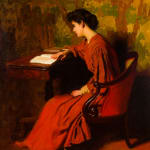Thomas Anshutz 1851-1912
Thomas Anshutz is remembered today primarily as one of the most gifted art teachers who shaped a generation of American artists, including figures as diverse as Robert Henri, Maxfield Parrish, and John Marin. He was profoundly influenced by Thomas Eakins, his teacher at the Philadelphia Sketch Club and Pennsylvania Academy of the Fine Arts. Following Eakins’ belief that figure painting required a detailed understanding of anatomy in order to correctly depict the body in motion, Anshutz mastered the subject and demonstrated dissections at the Pennsylvania Academy from 1878 until 1881, when he was made a full member of the faculty.
Perhaps because Anshutz spent so much time teaching, he painted only about 130 oils. After producing a masterful series of paintings, including the masterpiece The Ironworkers’ Noontime (1880; Fine Arts Museums of San Francisco, M. H. de Young Memorial Museum), Anshutz became absorbed in his teaching during the 1880s and painted little. When he married and returned to painting more frequently in the early 1890s, Anshutz moved beyond Eakins’ potent example to experiment with a variety of artistic approaches. He studied briefly in Paris, incorporated impressionist and post-impressionist methods into some of his works, and largely shifted from painting outdoor, agrarian subjects to more intimate interiors and portraits.
In his depiction of life-sized figures Thomas Anshutz continued a tradition of portraiture linking him to Whistler and Sargent. Anshutz worked from life, rapidly synthesizing the mood or impression of the sitter with surface effects of light. Two themes recur in his portraits of woman, the coquette and, as in this painting, the contemplative figure. Woman Reading at a Desk likely depicts Rebecca Harbert Whelen (1877–1950), one of the artist’s students and niece of Henry Whelen, the Treasurer and a member of the Board of Directors of the Pennsylvania Academy, who served that institution from 1886 until his death in 1907. Anshutz's association with the Academy, and with Whelan, spanned his lifetime, from his student years through those of Instructor and Dean of Faculty.
Rebecca Whelen was among Anshutz's favorite models: the subject of at least five major oils and two pastels, each executed between 1905 and 1910. Of these portraits, A Rose (1907; The Metropolitan Museum of Art, New York) and The Tanagra (1911, Pennsylvania Academy of the Fine Arts, Philadelphia), are the two best known.
For nearly eight decades Woman Reading at a Desk was owned by the Charlotte Cushman Club in Philadelphia. The Club, located at 1200 Locust Street, was founded by Lydia Elliot Morris in 1907 as a safe and respectable sanctuary and lodging for actresses appearing in local theaters. With time, the Club became a social center for the theater community and, in 1957, initiated a lifetime achievement for acting, eventually bestowing the honor on Helen Hayes, Henry Fonda, Angela Lansbury, Richard Burton, and Katharine Hepburn.
Provenance
The Charlotte Cushman Club, Philadelphia, by 1912 until 1984;Taggart, Jorgensen & Putnam, Washington, D.C.;
Mr. and Mrs. Stuart Bernstein, Washington, D.C., until 2014;
Hollis Taggart Gallery, New York;
Private collection, 2014 until the present



